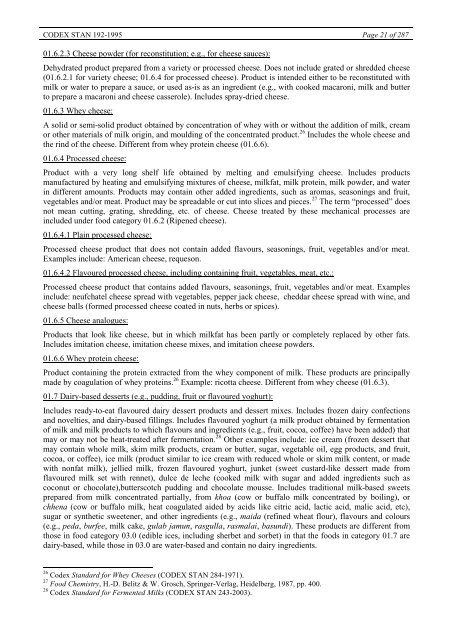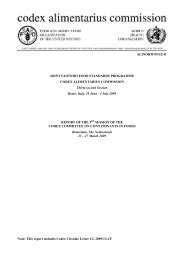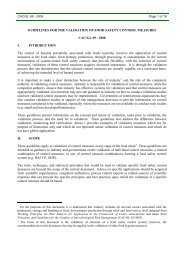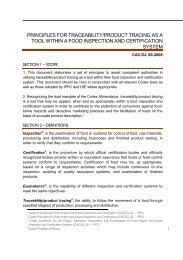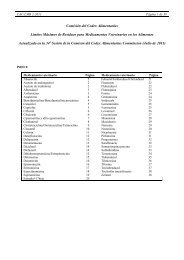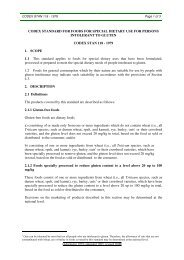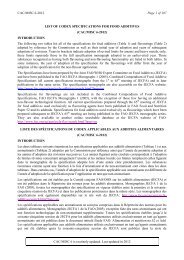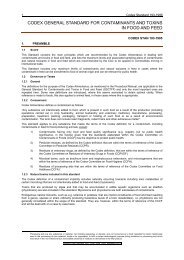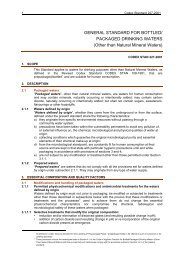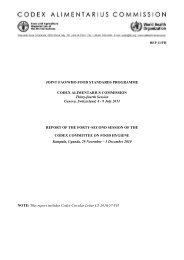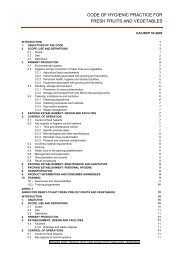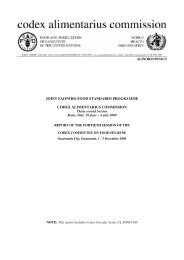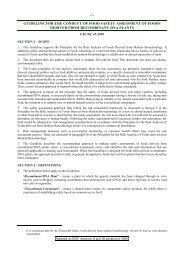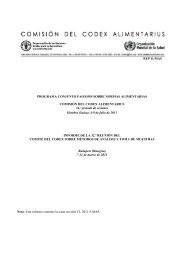General Standard for Food Additives - CODEX Alimentarius
General Standard for Food Additives - CODEX Alimentarius
General Standard for Food Additives - CODEX Alimentarius
Create successful ePaper yourself
Turn your PDF publications into a flip-book with our unique Google optimized e-Paper software.
<strong>CODEX</strong> STAN 192-1995 Page 21 of 287<br />
01.6.2.3 Cheese powder (<strong>for</strong> reconstitution; e.g., <strong>for</strong> cheese sauces):<br />
Dehydrated product prepared from a variety or processed cheese. Does not include grated or shredded cheese<br />
(01.6.2.1 <strong>for</strong> variety cheese; 01.6.4 <strong>for</strong> processed cheese). Product is intended either to be reconstituted with<br />
milk or water to prepare a sauce, or used as-is as an ingredient (e.g., with cooked macaroni, milk and butter<br />
to prepare a macaroni and cheese casserole). Includes spray-dried cheese.<br />
01.6.3 Whey cheese:<br />
A solid or semi-solid product obtained by concentration of whey with or without the addition of milk, cream<br />
26<br />
or other materials of milk origin, and moulding of the concentrated product. Includes the whole cheese and<br />
the rind of the cheese. Different from whey protein cheese (01.6.6).<br />
01.6.4 Processed cheese:<br />
Product with a very long shelf life obtained by melting and emulsifying cheese. Includes products<br />
manufactured by heating and emulsifying mixtures of cheese, milkfat, milk protein, milk powder, and water<br />
in different amounts. Products may contain other added ingredients, such as aromas, seasonings and fruit,<br />
27<br />
vegetables and/or meat. Product may be spreadable or cut into slices and pieces. The term “processed” does<br />
not mean cutting, grating, shredding, etc. of cheese. Cheese treated by these mechanical processes are<br />
included under food category 01.6.2 (Ripened cheese).<br />
01.6.4.1 Plain processed cheese:<br />
Processed cheese product that does not contain added flavours, seasonings, fruit, vegetables and/or meat.<br />
Examples include: American cheese, requeson.<br />
01.6.4.2 Flavoured processed cheese, including containing fruit, vegetables, meat, etc.:<br />
Processed cheese product that contains added flavours, seasonings, fruit, vegetables and/or meat. Examples<br />
include: neufchatel cheese spread with vegetables, pepper jack cheese, cheddar cheese spread with wine, and<br />
cheese balls (<strong>for</strong>med processed cheese coated in nuts, herbs or spices).<br />
01.6.5 Cheese analogues:<br />
Products that look like cheese, but in which milkfat has been partly or completely replaced by other fats.<br />
Includes imitation cheese, imitation cheese mixes, and imitation cheese powders.<br />
01.6.6 Whey protein cheese:<br />
Product containing the protein extracted from the whey component of milk. These products are principally<br />
made by coagulation of whey proteins.<br />
26 Example: ricotta cheese. Different from whey cheese (01.6.3).<br />
01.7 Dairy-based desserts (e.g., pudding, fruit or flavoured yoghurt):<br />
Includes ready-to-eat flavoured dairy dessert products and dessert mixes. Includes frozen dairy confections<br />
and novelties, and dairy-based fillings. Includes flavoured yoghurt (a milk product obtained by fermentation<br />
of milk and milk products to which flavours and ingredients (e.g., fruit, cocoa, coffee) have been added) that<br />
may or may not be heat-treated after fermentation.<br />
26<br />
Codex <strong>Standard</strong> <strong>for</strong> Whey Cheeses (<strong>CODEX</strong> STAN 284-1971).<br />
27<br />
<strong>Food</strong> Chemistry, H.-D. Belitz & W. Grosch, Springer-Verlag, Heidelberg, 1987, pp. 400.<br />
28<br />
Codex <strong>Standard</strong> <strong>for</strong> Fermented Milks (<strong>CODEX</strong> STAN 243-2003).<br />
28<br />
Other examples include: ice cream (frozen dessert that<br />
may contain whole milk, skim milk products, cream or butter, sugar, vegetable oil, egg products, and fruit,<br />
cocoa, or coffee), ice milk (product similar to ice cream with reduced whole or skim milk content, or made<br />
with nonfat milk), jellied milk, frozen flavoured yoghurt, junket (sweet custard-like dessert made from<br />
flavoured milk set with rennet), dulce de leche (cooked milk with sugar and added ingredients such as<br />
coconut or chocolate),butterscotch pudding and chocolate mousse. Includes traditional milk-based sweets<br />
prepared from milk concentrated partially, from khoa (cow or buffalo milk concentrated by boiling), or<br />
chhena (cow or buffalo milk, heat coagulated aided by acids like citric acid, lactic acid, malic acid, etc),<br />
sugar or synthetic sweetener, and other ingredients (e.g., maida (refined wheat flour), flavours and colours<br />
(e.g., peda, burfee, milk cake, gulab jamun, rasgulla, rasmalai, basundi). These products are different from<br />
those in food category 03.0 (edible ices, including sherbet and sorbet) in that the foods in category 01.7 are<br />
dairy-based, while those in 03.0 are water-based and contain no dairy ingredients.


